
A chessboard is a gameboard used to play chess. It consists of 64 squares, 8 rows by 8 columns, on which the chess pieces are placed. It is square in shape and uses two colours of squares, one light and one dark, in a chequered pattern. During play, the board is oriented such that each player's near-right corner square is a light square.
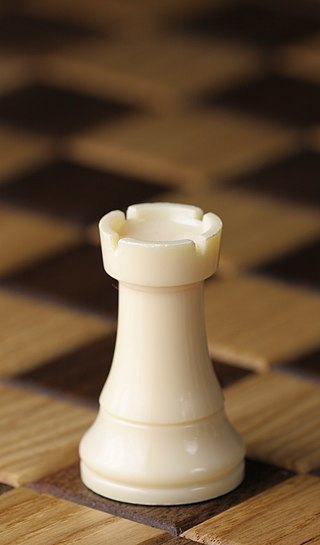
The rook is a piece in the game of chess. It may move any number of squares horizontally or vertically without jumping, and it may capture an enemy piece on its path; additionally, it may participate in castling. Each player starts the game with two rooks, one in each corner on their own side of the board.

The pawn is the most numerous and weakest piece in the game of chess. It may move one vacant square directly forward, it may move two vacant squares directly forward on its first move, and it may capture one square diagonally forward. Each player begins a game with eight pawns, one on each square of their second rank. The white pawns start on a2 through h2; the black pawns start on a7 through h7.
Chess libraries are library collections of books and periodicals on the game of chess. In 1913, preeminent chess historian H. J. R. Murray estimated the total number of books, magazines, and newspaper columns pertaining to chess to be about 5,000 at that time. B. H. Wood estimated that number, as of 1949, to be about 20,000. David Hooper and Kenneth Whyld write that, "Since then there has been a steady increase year by year of the number of new chess publications. No one knows how many have been printed..."
One of the most common ways for chess historians to trace when the board game chess entered a country is to look at the literature of that country. Although due to the names associated with chess sometimes being used for more than one game, the only certain reference to chess is often several hundred years later than uncertain earlier references. The following list contains the earliest references to chess or chess-like games.

Chaturanga is an ancient Indian strategy game. While there is some uncertainty, the prevailing view among chess historians is that it is the common ancestor of the board games chess (European), xiangqi (Chinese), janggi (Korean), shogi (Japanese), sittuyin (Burmese), makruk (Thai), and modern Indian chess.
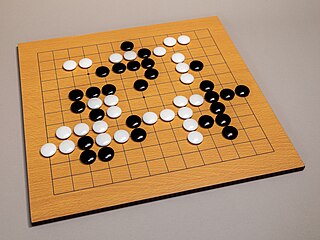
Abstract strategy games in contrast to strategy games in general usually have no or minimal narrative theme, outcomes determined only by player choice, and each players have perfect information about the game. For example, Go is a pure abstract strategy game since it fulfills all three criteria; chess and related games are nearly so but feature a recognizable theme of ancient warfare; and Stratego is borderline since it is deterministic, loosely based on 19th-century Napoleonic warfare, and features concealed information.
Hypermodernism is a school of chess that emerged after World War I. It featured challenges to the chess ideas of central European masters, including Wilhelm Steinitz's approach to the centre and the rules established by Siegbert Tarrasch.
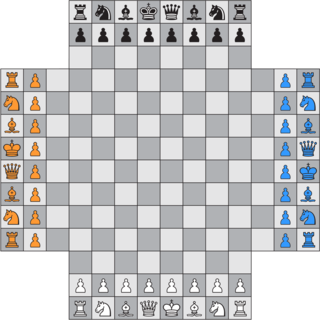
Four-player chess is a family of chess variants played with four people. The game features a special board typically made of a standard 8×8 square, with 3 rows of 8 cells each extending from each side, and requires two sets of differently colored pieces. The rules are similar to, but not the same as, regular chess. There are a variety of different rule variations; most variations, however, share a somewhat similar board and piece setup.
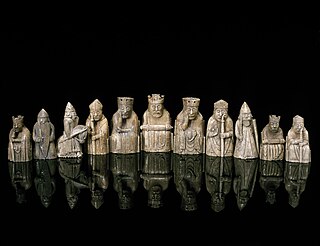
The history of chess can be traced back nearly 1500 years to its earliest known predecessor, called chaturanga, in India; its prehistory is the subject of speculation. From India it spread to Persia. Following the Arab invasion and conquest of Persia, chess was taken up by the Muslim world and subsequently spread to Europe via Spain and Italy. The game evolved roughly into its current form by about 1500 CE.

Chaturaji is a four-player chess-like game. It was first described in detail c. 1030 by Al-Biruni in his book India. Originally, this was a game of chance: the pieces to be moved were decided by rolling two dice. A diceless variant of the game was still played in India at the close of the 19th century.

Louis Paulsen was a German chess player. In the 1860s and 1870s, he was among the top players in the world. He was a younger brother of Wilfried Paulsen.
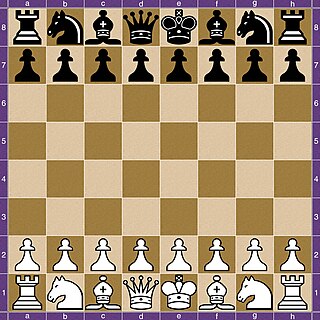
The game of chess is commonly divided into three phases: the opening, middlegame, and endgame. There is a large body of theory regarding how the game should be played in each of these phases, especially the opening and endgame. Those who write about chess theory, who are often also eminent players, are referred to as "theorists" or "theoreticians".
In chess and chess variants, a bare king is a game position where one player has only the king remaining.
Captain Joseph Bertin was one of the first authors to write about the game of chess. David Hooper and Kenneth Whyld in The Oxford Companion to Chess call his book The Noble Game of Chess "the first worthwhile chess book in the English language". B. Goulding Brown, writing in the December 1932 British Chess Magazine, called it the first original English chess book.

Le Palamède was the world's first periodical devoted to the game of chess. It was founded in France in 1836 by Louis-Charles Mahé de la Bourdonnais, who is often considered to have been an unofficial world chess champion. It ceased publication in 1839, but was revived in December 1841 by Pierre Charles Fournier de Saint-Amant, who continued publishing it until the end of 1847.

Libro de la invencion liberal y arte del juego del axedrez is one of the first books published about modern chess in Europe, after Pedro Damiano's 1512 book. It was written by Spanish priest Ruy López de Segura in 1561 and published in Alcalá de Henares.
Chaturanga is an ancient Indian game.
Captain Hiram Cox (1760–1799) was a British diplomat, serving in Bengal and Burma in the 18th century. The city of Cox's Bazar in Bangladesh is named after him.












